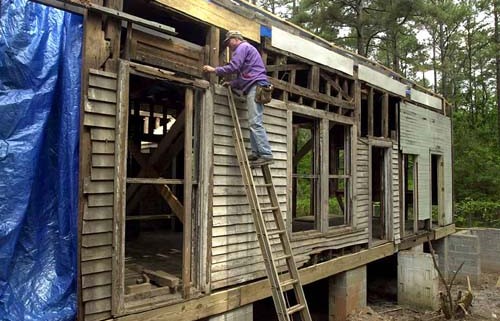Deconstruct, Don’t Destroy
It’s not a new idea to use something once and then repurpose it or its components for another use. But, with the prevalence of easily replaceable things and planned obsolescence, many things that could be reused are simply thrown away. Unfortunately sending trash to a landfill doesn’t make it disappear from the face of the earth – it’s simply ‘out of sight, out of mind.’ Fortunately, this mindset is beginning to change, as we’re confronted with overflowing landfills and environmental hazards. People are discovering that they can recycle not only plastic bottles, aluminum cans, and the like, but entire houses!
Did you know that a house can be recycled?
It’s not something that most recycling initiatives emphasize, and yet demolished homes represent a significant source of waste. In fact, between 200,000 and 300,000 houses are destroyed each year in the US. That’s over 120 million tons of materials being dumped in a landfill, most of which could be used to build new houses. These materials also pose an environmental hazard, as the toxic chemicals (e.g. mercury, chloride, asbestos, arsenic) they contain will eventually leach into the groundwater supply, and other substances, such as freon, will be released into the atmosphere from now open systems (e.g. HVAC).
Environmental considerations aside, deconstruction involves a common sense approach in terms of material use. Consider a child building a soapbox car. Suppose the child later wants to build a different car. He could destroy the car he made, rendering the parts unusable, and buy new wheels, a steering wheel, and uncut wood for the body. But he realizes that it would be better to take the first car apart and use its parts to build the new one. Thereby nothing is wasted.
So if deconstruction makes perfect sense on multiple levels, why don’t more building owners do it?
Demolition is easy, familiar, and costs less than deconstruction. Thus many owners go this route, especially in regions like the Rust Belt, where old, vacant houses are not only an eyesore but attract thieves and vagrants. Bankrupt cities with high unemployment, such as Detroit, don’t believe they can afford to deconstruct every house. Moreover, the recession hit American homeowners hard, and about 25% owe more on the mortgage than their house is worth. For people in this situation, demolition seems the best option. However, deconstruction provides social, environmental, and even financial benefits with which demolition can’t compete.
Deconstruction involves the careful, systematic disassembly of building components, piece by piece, in order to reclaim as many materials as possible. As you can imagine, this process requires planning and labor—indeed, it’s more than the job of a wrecking crew. Whereas a team of two with a track hoe and a dump truck can tear down a house in a day, it takes 3-15 days for six workers to deconstruct it. These “green-collar” workers usually undergo extensive training, often on the job, to learn how to maximize material recovery.
Deconstruction workers operate according to the “last in, first out” rule.
That is, they remove the components that were installed last in the house, first. So they start with interior surfaces, taking out all appliances, fixtures, flooring, molding, carpets, trim, and doors. Next they strip the drywall or plaster from the walls and ceilings, but this rarely can be reused because of the lead-based paint applied to it years ago. After removing the interior subflooring and studs, the workers detach the roof shingles; sub-roof boards; all ferrous, aluminum, and copper metal; rafters and roof trusses; and joists and studs. They then take out plumbing, wiring, HVAC ducts, and insulation. The cinder block foundation walls, brick chimney, brick or wood exterior walls, and concrete slab are the last to go.
Depending on the owner’s needs, the house can be deconstructed in whole or in part. Most deconstruction companies aim to recycle at least 70% of the materials. The building owner may reuse the materials in a new structure or give them to friends and neighbors. Alternately, you can receive a major tax deduction ($40,000 to $100,000) by donating the materials to a non-profit such as Second Chance, Community Forklift, or Habitat for Humanity.
 Your community can benefit greatly because the local deconstruction company creates jobs and increases the supply of building components. On the one hand, unemployed people, including ex-criminals, receive practical, hands-on training at the deconstruction site and the materials plant/warehouse. Second Chance, for example, has a wonderful job training program, teaching workers life skills, safety skills, and technical skills. At the end of the program, graduates come away with solid work habits and people skills, as well as knowledge of materials, deconstruction techniques, occupational safety and health, sustainability, and the LEED rating system. They can also train to enter vocational careers in the fields of manufacturing, carpentry, restoration, electrical, plumbing, and masonry. Individuals who were once down-and-out can become successful in the green industry and increase their quality of life.
Your community can benefit greatly because the local deconstruction company creates jobs and increases the supply of building components. On the one hand, unemployed people, including ex-criminals, receive practical, hands-on training at the deconstruction site and the materials plant/warehouse. Second Chance, for example, has a wonderful job training program, teaching workers life skills, safety skills, and technical skills. At the end of the program, graduates come away with solid work habits and people skills, as well as knowledge of materials, deconstruction techniques, occupational safety and health, sustainability, and the LEED rating system. They can also train to enter vocational careers in the fields of manufacturing, carpentry, restoration, electrical, plumbing, and masonry. Individuals who were once down-and-out can become successful in the green industry and increase their quality of life.
On the other hand, the community benefits from the increased employment, but also from the abundance of inexpensive, useable materials. For instance, a typical 2,000-square-foot wood frame house can be deconstructed into 6,000 board feet of lumber (as opposed to 10,000 cubic feet of debris). Built-in cabinets and other fixtures can also be reused. Offices, schools, houses, churches—you name it!—can all be built or furnished at low cost. In addition, the local government does not have to spend as much taxpayer money on landfill/incinerator operations and transport, enabling it to give tax incentives for deconstruction.
We hope that deconstruction will one day replace demolition, but currently only a few thousand homes are deconstructed out of the hundreds of thousands destroyed each year. In a capitalist society, the environmental benefits of an activity will never be enough to motivate everyone to engage in it. These must be reinforced with financial and social incentives, and deconstruction has achieved a remarkable balance between all three, so that materials and money flow cyclically through the community. What remains now is to educate homeowners before they decide to turn to demolition as the customary, age-old method. Deconstruction companies must continue to make themselves known in the community through assisting in the tax process, employing workers, and supplying materials. In this way, these organizations give a “second chance” to both people and resources.
References:
http://www.secondchanceinc.org/index.aspx?u=What_is_Deconstruction
http://www.secondchanceinc.org/index.aspx?u=How_It_Works
http://www.secondchanceinc.org/index.aspx?u=Benefits_of_Deconstruction
http://realestate.msn.com/dont-demolish-that-old-house-recycle-it
http://www.reuseconsulting.com/Deconstruction.php
http://www.deconstructionservices.com/
http://www.deconstructionservices.com/DeconProcessSummary.pdf
http://www.theatlantic.com/business/archive/2011/06/are-there-too-many-homes-in-america/240786/
http://www.cbsnews.com/news/there-goes-the-neighborhood-57344513/
http://news.yahoo.com/home-demolitions-turn-detroit-blank-canvas-050316719.html
http://homebuying.about.com/od/investmentproperties/qt/92707_TearDown.htm
Photo credit: http://onlineathens.com/stories/043004/g_cobb2.shtml#.VR7ZyZPF–c




Leave a Reply
Want to join the discussion?Feel free to contribute!